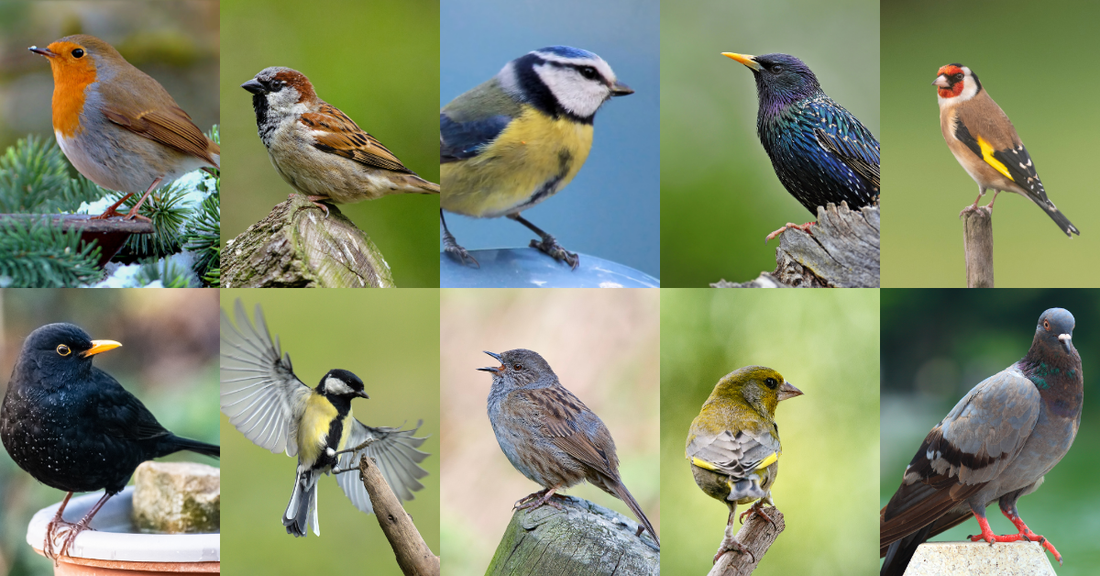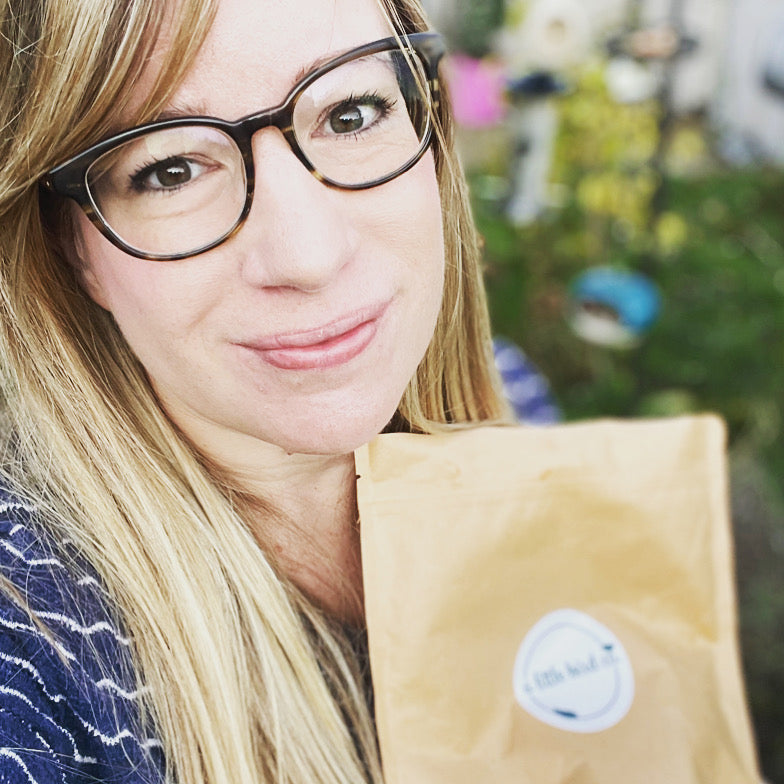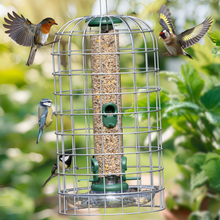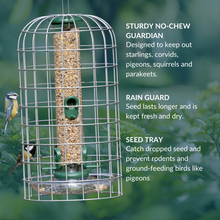Prepare for the RSPB Big Garden Birdwatch: A Q&A on the ten commonly seen British Birds

Welcome to our guide to British garden birds! Inspired by the Big Garden Birdwatch, we'll be answering 10 common questions about the UK's most frequently spotted British birds. Whether you're a seasoned birdwatcher or just getting started, you'll find plenty of fascinating facts and tips to help you make your garden a welcoming place for birds.
Are coal tits using your nesting box?
Coal tits are some of the busiest garden visitors, easily identified by their small size and distinctive black-and-white markings. Weighing about the same as a 50p coin, they’re smaller than blue tits and great tits. Look for the white stripe at the back of their head and white wing markings, which help distinguish them from marsh and willow tits. Their rapid, high-pitched song often includes a siren-like call.
Adapted to coniferous woodlands, coal tits use their slim beaks to forage for seeds and insects but happily visit feeders for sunflower hearts, suet, and peanuts. Known for caching food, they dart back and forth, hiding seeds in crevices to save for later. Nest boxes can also become storage spots, and it’s easy to mistake this behaviour for early nesting activity (I did this a few years back!). However, their clever caching doesn’t always succeed—they often forget hiding spots or lose their stores to bolder great tits.
Coal tits are agile and quick, often hanging upside down on branches or feeders. Though often solitary, they form mixed flocks with other tit species in winter. Nesting starts in April, with females building cup-shaped nests from moss, spider webs, and feathers in tree holes, burrows, or nest boxes. They lay up to ten tiny, speckled eggs, which hatch after two weeks. Both parents feed the chicks until they fledge at 16–19 days. Coal tits are widespread across Europe, parts of Asia, and North Africa, with close relatives like the chickadee found in North America. Their resourceful habits and adaptability make them fascinating to watch.
To encourage coal tits into your garden, try adding a wooden nest box - for tips, you can check out our blog post here.
How do you attract robins to your garden?
Robins are one of the most well-loved garden birds, and they’re likely to make a special appearance at your feeder if you’ve got the right food. Known for their bold personalities and tame natures, robins are often seen hopping around while we garden, and they’ll often join us for a chat if they’re hungry or can see where digging up worms.
During the winter, robins are especially territorial and will defend their patch from other birds. They’re also quick to claim a feeding spot, so offering a steady supply of food like our Seasonal Wild Bird Food Blend will encourage robins to stick around. This blend is perfect for them, providing a mix of seeds that support their high-energy needs all year round. Robins are opportunistic nesters, often favouring open-fronted spaces positioned fairly low to the ground. Many of our customers have found success attracting robins by using a woven nester or a multi-species nest box with the front panel removed. That said, these resourceful birds are just as likely to settle into more unusual spots—such as an old pair of wellies left outside!
These iconic little birds have a varied and sweet song, heard throughout the year, and they’re often one of the first to sing in the morning and one of the last to stop at night. Whether they’re building nests in unusual places like plant pots or wheelie bins or serenading you with their cheerful tune, robins are a special addition to any garden.
How do you tell a male blue tit from a female?
Blue tits are a familiar sight in many gardens and offer endless entertainment with their energetic behaviour. These social birds, easily identified by their black eye band and vibrant blue feathers, are a treat to watch as they dart around feeding on insects and food you offer.
To attract blue tits to your garden, we recommend using our Seasonal Wild Bird Food Blend, which includes a mix of seeds blue tits love, providing them with all the energy they need for foraging and nesting.
Male blue tits are more vividly coloured than females, with bright yellow breast feathers that become even more intense when their diet is rich in caterpillars. The more yellow a male's feathers, the more caterpillars he’s eaten, signalling his health and fitness to potential mates. Interestingly, their vibrant colouring is more visible to other birds than to us, as blue tits can see ultraviolet light, which enhances their plumage’s brilliance.
Blue tits have excellent spatial memory, enabling them to relocate hidden food stores with ease. Their behaviour is fascinating—during courtship, males preen and sing elaborate melodies to impress females. They also engage in "anting," a behaviour where they rub ants on their feathers to help control parasites.
Unlike robins, who are fiercely territorial and solitary, blue tits are social birds and often seen in flocks outside the breeding season. This social nature has allowed them to learn from one another, which famously led to their discovery of pecking through the foil lids of milk bottles to access cream—a behaviour passed down through generations. Robins, on the other hand, lack this social structure and are unlikely to adopt similar behaviours.
How can I attract goldfinches to my garden?
Goldfinches are a beautiful sight in the garden, and they’re known for their striking appearance with red faces and golden wings. I love to see a goldfinch - they're my lucky birds. These social birds often gather in large flocks during autumn, known as a "charm," and are particularly attracted to areas with lots of food and cover.
To encourage goldfinches into your garden, offer them our Seasonal Wild Bird Food Blend, which they’ll love. This blend provides the right mix of seeds, calcium, suet and mealworms to support them year-round, from their spring breeding season to gathering in their autumn flocks.
In the wild, goldfinches feed on thistles, teasels, and other seed-rich plants, and they’ll appreciate any leftover seeds you leave in your garden after flowering. They’re also known for their beautiful, rippling song and dipping flight. Goldfinches are a relatively common site in our British gardens today, although they were in decline during Victorian times when they were captured and caged as pets. The declining number of goldfinches in the UK was one of the first priorities of the RSPB when the organisation was first set up.
Are house sparrows endangered?
House sparrows are one of the most familiar garden birds, often seen in urban areas and suburban gardens. These social and lively birds are easily recognisable, with the males sporting a brown head, white cheeks, a buff tummy, and a black bib, while the females have a more understated tawny brown plumage and a distinctive cream stripe behind the eye. Although house sparrows seem common, they’re actually in decline across the UK, and are currently on the BTO red list. Factors like the decrease in invertebrate numbers, modern garden designs with little cover, and a rise in predatory cats have contributed to the drop in their population. Despite this, house sparrows are resilient and adaptable. To help bring sparrows back to your garden, you can create the perfect environment for them by planting hawthorn, ivy, and wild roses. Let your lawn grow a bit longer during the summer, and leave it uncut through winter. A patch of grass and weeds left to grow year-round will provide the insects and spiders sparrows need to feed their young.
During the breeding season, male house sparrows sing energetically to attract a mate, and once a pair is established, they work together to raise their brood. The male builds a dome-shaped nest in a sheltered spot, like the crevice of a wall or under roof eaves, and the female lines it with soft materials. After laying 4-7 eggs, she incubates them for about 10-14 days, and the chicks fledge around two weeks old.
Sparrows are social birds and often nest in colonies, with several pairs building nests in close proximity. This allows them to protect their young together and thrive in a community. With their hardworking nature and strong bonds, house sparrows are a wonderful symbol of cooperation and resilience.
In various cultures, sparrows are seen as symbols of productivity, love, and good fortune, and in Ancient Egypt, sailors would often get sparrow tattoos to ensure their souls would be carried home if they died at sea. So, when you spot a house sparrow in your garden, remember to appreciate its hardworking spirit and the joy it brings to our outdoor spaces.
How do I stop wood pigeons from eating all the bird food?
Before we dive into how to keep wood pigeons from helping themselves to your bird food, let’s take a moment to appreciate these charming, larger-than-life garden visitors. What would a garden be without a wood pigeon or two strutting about beneath the feeders?
Once considered woodland dwellers, wood pigeons have adapted well to urban spaces and are now our most commonly seen pigeon species. Their slate blue feathers, accented with flashes of iridescent purple, pink, and green, and their unmistakable “coo-cooo-coo coo-coo” call make them easily identifiable. Wood pigeons are a social bunch, forming large flocks but fiercely defending their territory when it comes to breeding season.
However, their enormous appetites can quickly become a problem. These big birds love to feast on a variety of foods, including vegetables, seeds, nuts, and grains. It’s no surprise they’re often seen under the feeders—looking for a snack after a day of feeding on whatever they can find, and it's definitely understandable that we all get more than a little frustrated when we see them waddling about in the garden.
So, what can you do to keep them from eating up all the bird food you’ve put out for smaller visitors? First, remember that wood pigeons are part of the wild beauty of your garden, and the challenge isn’t to stop them, but to find a balance that allows everyone to share the space.
Here are a few ideas to manage their appetite without being overly restrictive:
-
Use feeders designed for smaller birds: These can help keep larger pigeons at bay while still allowing the little ones to enjoy the food. A feeder with a cage (like our starling proof feeder set up) or a weight-activated design (like our Squirrel Buster) can make it harder for the pigeons to access the food.
-
Provide alternative food sources: Wood pigeons are always looking for something to munch on, so offering food in other parts of your garden might encourage them to forage elsewhere. Planting shrubs or leaving certain areas of your garden to grow wild can help satisfy their cravings.
-
Offer a variety of food at different times: While wood pigeons may want to eat from your bird feeders, providing ground feed or seed mixes in other areas will help attract different birds, giving your feeders a more diverse crowd.
By understanding the habits and preferences of these fascinating birds, you can create a welcoming garden where every species gets a chance to thrive. And who knows—maybe you’ll come to appreciate the presence of the wood pigeons just as much as the smaller birds you’re trying to attract.
How do I tell the difference between a great tit and a blue tit?
The great tit, scientifically known as Parus major, is one of Europe’s most beloved and easily recognisable bird species. With its striking black, white, and yellow plumage, it's a common sight in gardens, woodlands, and parks. Despite its small size, this beautiful bird has a big appetite at the bird feeder, favouring sunflower hearts, peanuts, and suet.
Though often confused with the blue tit by newbie birders, the two are quite different. Great tits are a bit larger, with a plump body, longer beak, and a sharp black stripe running from the beak to the feet. Their distinctive "teacher-teacher" call is louder and bolder than the blue tit’s delicate "tseetsee" song, making them easier to spot by ear. Great tits are also braver, often lingering at the feeder while blue tits flit in and out.
In the spring, male great tits sing to attract females, often performing acrobatic displays to show off their agility. Paired great tit couples build nests with leaves, moss, and twigs, and the female lays a clutch of 6-12 eggs, which both parents feed until the young fledge.
Great tits are always eager to use a nest box during the breeding season, especially one with a 32mm entrance hole. In folklore, they are thought to carry the souls of the dead, while in Japan, they are symbols of protection and good fortune.
How can I tell the difference between a dunnock and a house sparrow?
The dunnock, often overlooked, is a small bird that can be found rustling in hedgerows and brambles. If you hear a rustling sound during your walk, it’s likely to be a dunnock rather than a mouse. These birds, with their soft brown plumage, are generally seen feeding on the ground under shrubs or hedges, flicking their wings as they search for insects, worms, and seeds.
At first glance, dunnocks may look similar to house sparrows, but there are key differences. Dunnocks are slimmer with a more delicate beak, and they belong to the accentor family, not the sparrow family. Their colouring is more muted than the house sparrow’s, and they tend to be smaller with a sleeker, more slender body. While house sparrows are often seen on bird feeders, dunnocks prefer to stay out of sight, foraging at the base of hedges or shrubs and darting back to cover after grabbing some food.
Dunnocks have an unusual breeding system. Females mate with multiple males, and the males help raise the chicks, often assuming they’ve fathered some of them. This leads to a strict hierarchy within the flock, with older, more dominant birds taking charge. In contrast, house sparrows typically form more traditional pairings.
Dunnocks build their nests low down in bushes or hedges, using twigs and moss, and line them with feathers. Their eggs, which are unspotted and blue, are incubated for around two weeks before they fledge. Despite their quiet nature, dunnocks play a key role in their ecosystem, often overlooked but always present in our gardens and woodlands.
How do I stop starlings eating all the bird food?
Starlings are bold, communal feeders known for their ability to empty bird feeders in no time. They gather in flocks, making a group visit to your garden a lively event! Though their numbers may seem overwhelming, it’s worth noting that starlings are on the UK conservation red list due to a dramatic population decline since the 1980s.
Starlings have a varied diet, including insects, worms, and seeds, which they find in nature and on bird tables. They’re particularly attracted to high-energy foods like suet, making them frequent visitors in colder months when food is scarce. During autumn and winter, starlings from Eastern Europe join our resident birds, increasing their numbers.
If starlings dominate your feeders, consider using a cage-style feeder or a Squirrel Buster Classic with the feeding perches removed, which allows access for smaller birds while starlings feed separately on a bird table.
Despite their reputation, starlings play an important ecological role and need support. Their flocking behaviour, including the breathtaking murmurations seen in autumn and winter, is a survival strategy to confuse predators and conserve warmth. While their noisy, gregarious nature may not make them everyone’s favourite, starlings bring energy and spectacle to our gardens and skies.
How can I help prevent trichomonosis in greenfinches?
Greenfinches, with their vivid green plumage and cheerful song, are found across most of the British Isles. Once countryside dwellers, they’ve adapted to urban life, nesting in evergreen hedges and visiting our feeders for sunflower hearts, suet, hemp seed, and peanuts. These sociable birds often share feeders with tree sparrows, yellowhammers, and reed buntings, though they can squabble amongst themselves.
Despite their charm, greenfinches face challenges. Their population has fluctuated, with recent declines linked to trichomonosis, a parasitic disease that affects their ability to feed. Infected birds may appear lethargic, puffed up, or drool and regurgitate food, spreading the disease at feeders and bird baths.
Luckily, trichomonosis doesn’t survive long outside a host. To protect greenfinches and other garden birds, clean and disinfect feeders regularly, and change bird bath water daily. You can also set up more than one bird feeding station in the garden so that there is less pressure on each feeder. These simple steps can help ensure your garden remains a safe haven for these lovely birds, supporting their survival while we enjoy their vibrant presence.
How can I tell a blackbird, starling, jackdaw, and crow apart?
Blackbirds, part of the thrush family, are well-known garden visitors. The males stand out with their bright orange beak and eye ring, while females are a subtler brown in order to blend in with the foliage when they're sitting on their eggs. Their melodious song adds charm to our gardens year-round, with UK residents joined by migrating blackbirds in summer and winter.
These omnivorous birds feed on earthworms, insects, berries, and even small amphibians or mammals. They prefer ground-level feeders near cover and nest in parks or residential areas.
Interestingly, blackbirds use only one eye at a time and are capable of unhemispheric slow-wave sleep—keeping one half of their brain awake to watch for danger, a defence shared with dolphins and seals. Their nests, often poorly concealed in ivy or trees, hold 2–5 eggs, which hatch after 12–14 days.
Celtic folklore calls blackbirds one of the oldest animals in the world, and in Ireland, spotting two together is considered lucky. They’ve also been linked to the pirate Blackbeard, featuring in the coded song “Sing a Song of Sixpence,” used to lure sailors to his ship.
To distinguish a blackbird from starlings, jackdaws, and crows, focus on their size, colour, and markings. Blackbirds are smaller, with a sleek black appearance in males and a brown hue in females. Starlings, slightly smaller, have iridescent black feathers that shimmer green or purple in sunlight. Jackdaws, compact members of the crow family, sport a grey nape and lighter eyes. Crows are the largest, with solid black plumage and a robust, straight beak. Their size and call are key giveaways compared to the more delicate blackbird.
With a little effort, your garden can become a haven for a wide variety of birds. Whether you’re setting up feeders, planting wildlife-friendly shrubs, or simply enjoying the sounds of birdsong, there’s always something new to discover. Share your sightings with us on Instagram @alittlebirdcompanyuk, and don’t forget to document your birdwatching adventures with our Birdwatching Journal. Happy birding!

















